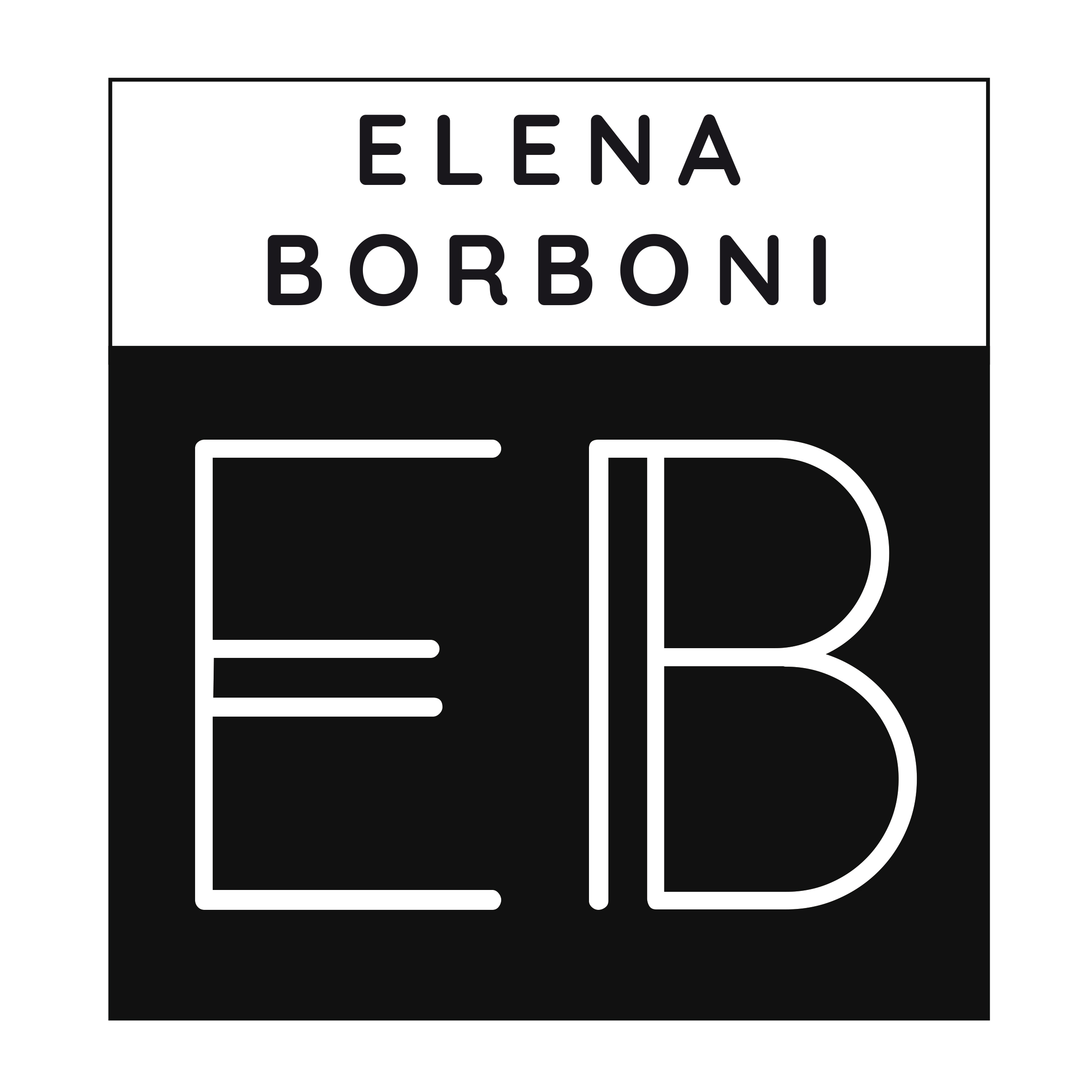Elena Borboni, un avvolgente percorso all’interno delle profondità della vita tra Simbolismo e Materia
Da Marta Lock -18 Febbraio 2022
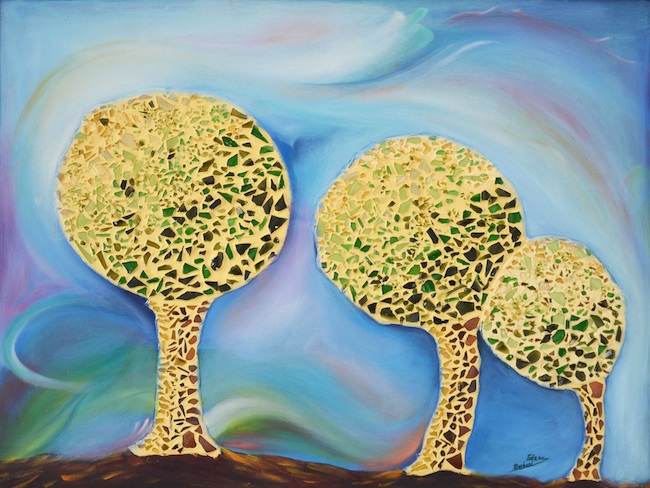
A volte il significato intrinseco, il senso più nascosto di ogni elemento che circonda l’essere umano, diviene protagonista assoluto dello stile di alcuni artisti contemporanei che mostrano la particolare attitudine a scendere verso quelle profondità che appartengono non solo all’uomo bensì anche a tutto ciò che avvolge l’esistenza pur assumendo un ruolo apparentemente marginale; quella che in passato era stata una connessione con la spiritualità, un momento di mediazione tra umano e divino, nell’attualità ha un approccio più introspettivo, più legato al quotidiano, all’interazione costante con quelle energie sottili che avvolgono l’esistenza in maniera forte ma altrettanto spesso inascoltata. L’artista di cui vi racconterò oggi ha la particolare dote di porsi in attento ascolto di quelle energie e di farle diventare il fulcro della sua produzione.
Intorno alla fine dell’Ottocento vide la luce in Francia un movimento destinato a cambiare radicalmente il rapporto tra manifestazione espressiva e connessione con le forze esterne all’essere umano che aleggiano intorno alla quotidianità pur restando in silenzio, misteriose, al di fuori della comprensione; gli artisti appartenenti al Simbolismo, questo il nome del nuovo movimento pittorico, lasciavano invece emergere la spiritualità di tutto ciò che esiste e che risulta invisibile allo sguardo materialista dell’uomo, spingendosi a ricercare il significato profondo, il contatto con una natura e il nesso spirituale all’interno di essa, partendo dal punto di vista dell’esecutore dell’opera. Il soggetto diveniva così la proiezione dell’emotività e delle sensazioni percepite dall’artista che si spingeva oltre andando a irradiare la forma riprodotta dell’idea generata dal sentire, dall’osservare ciò che nella realtà era semplicemente visibile. Ciò che risultò più importante nel percorso del Simbolismo fu l’attenzione all’universo sommerso delle percezioni, della soggettività che doveva prevalere sull’oggettività, la quale invece era la principale prerogativa delle correnti artistiche del Realismo e anche dell’Impressionismo; tuttavia l’attenzione a temi prevalentemente religiosi, filosofici e spirituali resero il movimento pittorico accessibile solo a un ristretto pubblico di intellettuali in grado di cogliere i messaggi subliminali e sottili delle opere di grandi maestri come Odilon Redon, Gustave Moreau e Arnold Böcklin. Il percorso di trasformazione dell’arte però era stato avviato e le successive evoluzioni artistiche del Novecento cercarono di mantenere quel forte legame con il mondo interiore trasportandolo verso lo studio della mente umana, dei suoi incubi e dei suoi sogni, come nel Surrealismo, oppure nella scoperta del mistero nascosto dentro gli oggetti, i luoghi che nel silenzio nascondono il senso della vita, il rapporto con il passato per vivere con più consapevolezza il presente, come nella Metafisica, per finire con la completa supremazia dell’emozione su qualsiasi forma visibile, estremizzazione dell’esigenza di lasciar parlare esattamente quel sottile legame tra il soggetto e la connessione con tutto ciò che lo circonda e in virtù del quale egli non ha bisogno di aggrapparsi a una realtà riconoscibile. In particolar modo l’Informale Materico spinse gli artisti aderenti a questo movimento a trovare nella materia un mezzo per restare connessi con una realtà, con la concretezza funzionale a esaltare le sensazioni provate e al tempo stesso scolpirle all’interno della tela in cui la volatilità dell’astrazione necessitava un appiglio con la solidità. L’artista bresciana Elena Borboni compie un percorso di approfondimento nel quale l’ascolto nei confronti dei reali significati di tutto ciò che circonda l’essere umano e che appartiene alla natura deve essere manifestato e considerato come una capsula avvolgente nella quale in fondo è bello rifugiarsi, in cui non può fare a meno di infondere anche la consistenza della materia, come se per lei la connessione con la robustezza fosse indispensabile per creare quella magica unione tra ciò che è interno e ciò che è esterno.
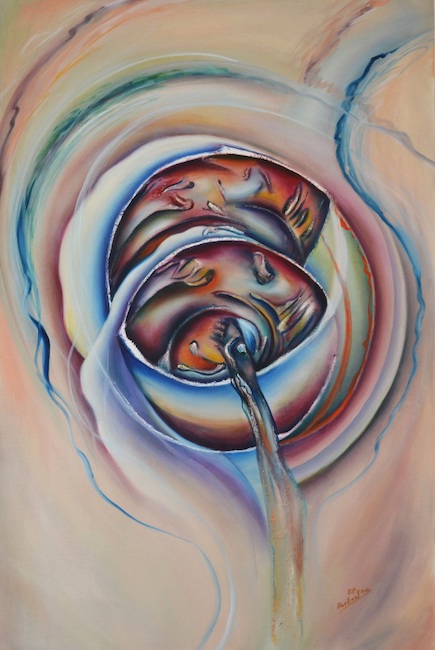
Lo sguardo che rivolge alla natura è quello meravigliato di chi conosce la ricchezza e la profondità di tutto ciò che circonda la vita, che ha un suo senso profondo ma visibile solo a chi possiede, come lei, una particolare sensibilità in grado di captare quelle energie sottili, quel filo che collega tutti gli eventi e che si rigenera nella circolarità dell’evoluzione naturale.
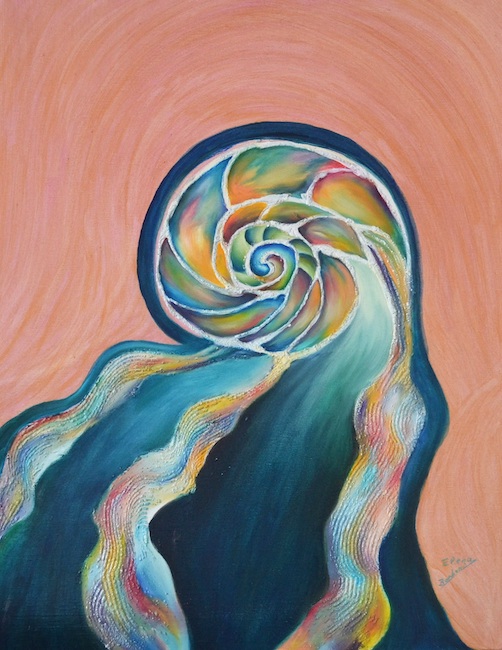
Ciò che affascina la Borboni è il fluire della cromaticità, quello scorrere dei colori come se nel loro mescolarsi generassero a loro volta un canale energetico ma anche lirico che contraddistingue le emozioni di cui l’artista scopre di voler parlare nel momento in cui si siede davanti alla tela e lascia che una nuova opera prenda vita.
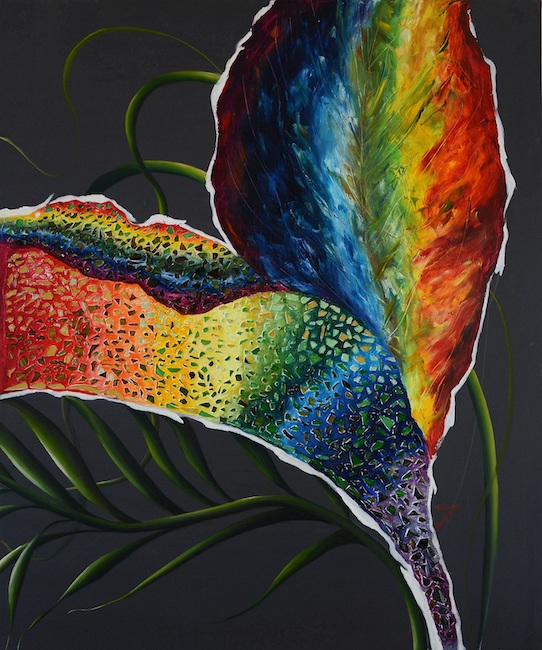
A volte la figurazione si perde dentro l’astrazione generando un’illusione ottica in cui i simboli rimangono sottintesi pur lasciando spazio alle tonalità emozionali che definiscono il concetto più esteso, in altre tele invece il soggetto principale spicca sulla tela in maniera metafisica, proprio per permettere al senso insito nell’elemento naturale, scelto dall’artista per essere protagonista dell’opera, di amplificare il suo messaggio, di indurre l’osservatore a percepirne la voce. Eppure a volte il solo colore, quella fluidità cromatica che contraddistingue la produzione artistica di Elena Borboni, non è sufficiente perché si fa strada la necessità della concretezza, dell’amalgama con la materia che costituisce una radice essenziale nell’esistenza, una consistenza di cui l’essere umano ha bisogno per non perdersi dentro il vortice di una travolgente emotività.
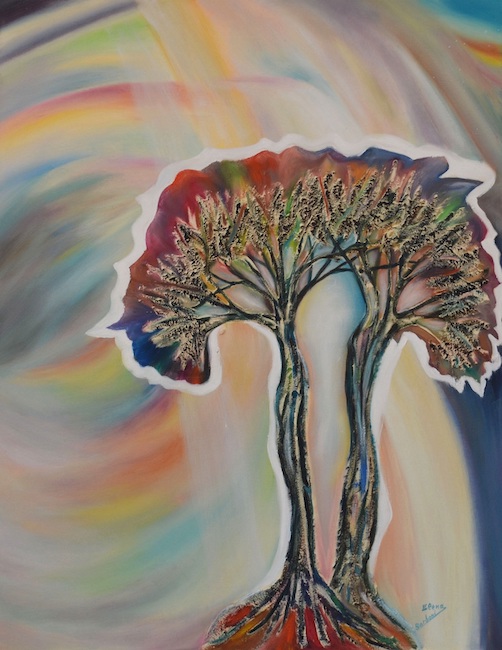
L’opera Avviluppante amorevolezza presenta infatti uno sfondo completamente emozionale, fatto di sensazioni sussurrate, di morbidezza che sembra avvolgere e carezzare lo sguardo dell’osservatore solo in un secondo momento attratto dal soggetto effettivo della tela, quei due alberi le cui chiome sembrano essere un’intensificazione dello sfondo e i cui tronchi sono costituiti dall’elemento materico; il messaggio sembra essere che spesso ciò che appare più coriaceo, più resistente, abbia in realtà un maggior bisogno di dolcezza, di sentirsi rassicurato in quel mondo emozionale che spesso tende a essere lasciato in secondo piano rispetto alla forza esteriore. Le radici degli alberi costituiscono la solidità necessaria all’essere umano, ma il loro innalzarsi verso il cielo è un naturale tendere verso l’infinito, verso una crescita, un’evoluzione che l’individuo desidera per migliorare se stesso.
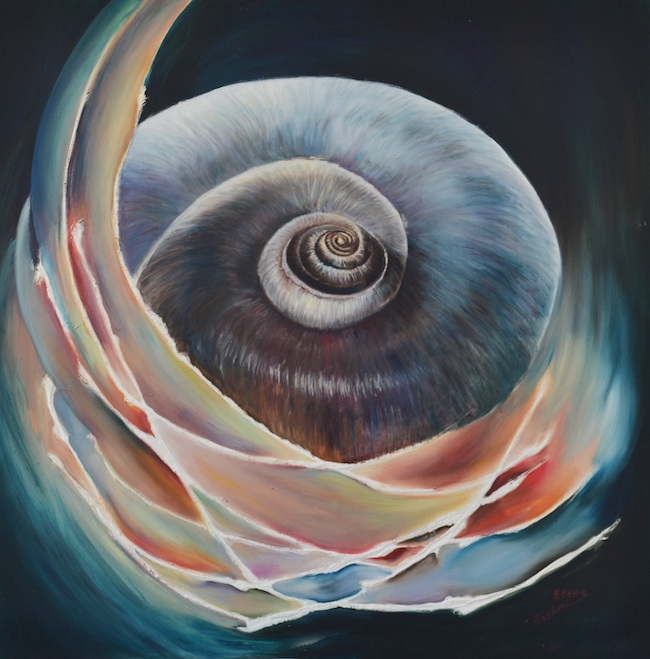
In Sussurro di memorie Elena Borboni usa la spirale, uno dei suoi simboli preferiti, per narrare la circolarità dei ricordi, quei frammenti che tratteggiano la personalità di ciascuno e che formano convinzioni a volte limitanti, altre invece funzionali a proseguire in maniera più decisa e sicura nel cammino della vita; la spirale tende a liberarsi verso l’esterno e il suo nucleo, quella parte iniziale che l’individuo tende a proteggere quasi come se fosse per lui impossibile lasciarla alle spalle, si dipana lentamente per accogliere il nuovo fino a quando il ricordo, pur restando dolcemente legato a un tratto del percorso di vita, non costituisce più un impedimento per protendersi verso un nuovo futuro.
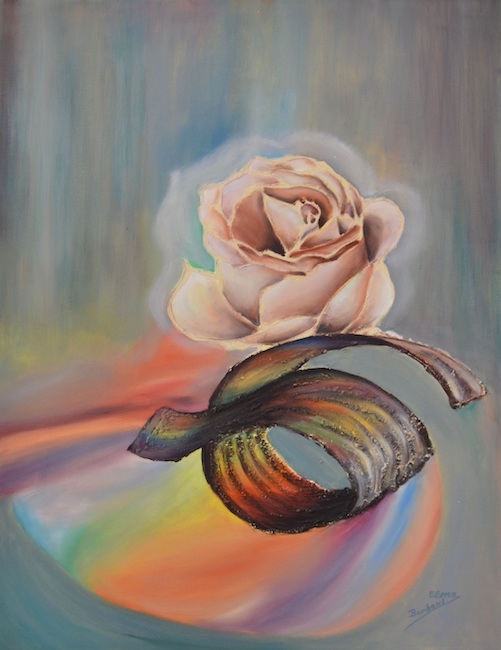
E ancora in Vibrante armonia, opera decisamente tendente alla Metafisica sia per la decontestualizzazione del soggetto protagonista, la rosa, sia per l’aura meditativa ed enigmatica che il dipinto infonde, come se desiderasse indurre l’osservatore a lasciarsi trasportare dall’armonia di cui parla il titolo, come se la leggera spirale che sembra sostenere la rosa fosse magnetica nei confronti delle corde emotive di chi si trova davanti alla tela. La rosa rappresenta per Elena Borboni un altro elemento fondamentale dell’esistenza, quello della maternità, della capacità di generare vita e dunque diventa un simbolo dell’individuo che trova un nuovo sé, che scopre quanto si possa nascere non solo una bensì due, dieci, cento volte qualora si riesca a essere aperti a quell’evoluzione a cui molti resistono lasciando che accada piuttosto che esserne protagonisti consapevoli.
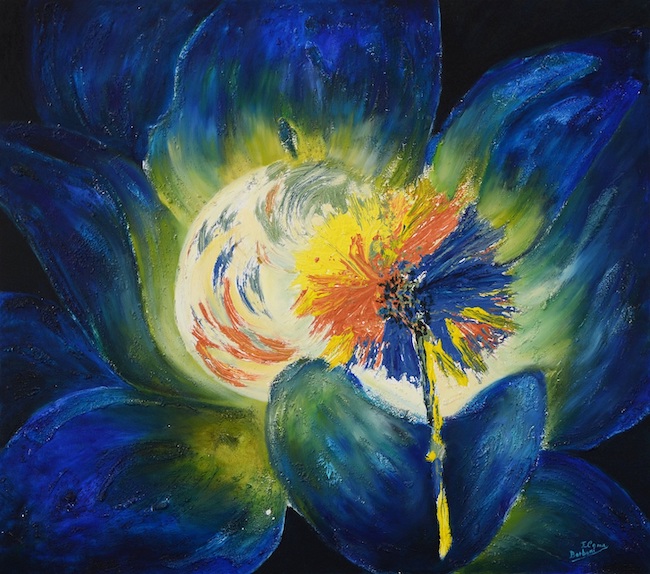
Poi in Luce che abbraccia il mondo si sposta verso l’Espressionismo Astratto, quel lasciare appena accennato un tarassaco, simbolicamente propulsore di vita con i suoi piumini leggeri e volatili, che si amalgama con la luce, con i colori, con le tonalità intense in grado di illuminare il buio intorno proprio in virtù di una forza cromatica, interpretabile con la determinazione positiva della resilienza, della capacità di resistere alle avversità nella convinzione che tutto possa cambiare. Elena Borboni ha al suo attivo numerose mostre collettive sia in Italia che all’estero e le sue opere sono state premiate ben quattro volte in diversi concorsi pittorici.
ELENA BORBONI-CONTATTI
Email: info@elenaborboni.it
Sito web: www.elenaborboni.it
Facebook: https://www.facebook.com/elenaborboniArtGallery
https://www.facebook.com/elena.borboni
Instagram: https://www.instagram.com/eborboni/
Elena Borboni, an enveloping journey into the depths of life between Symbolism and Matter
Sometimes the intrinsic meaning, the most hidden meaning of every element that surrounds the human being, becomes the absolute protagonist of the style of some contemporary artists who show a particular aptitude for descending into those depths that belong not only to man but also to everything that envelops existence, even if it assumes an apparently marginal role; what in the past had been a connection with spirituality, a moment of mediation between the human and the divine, now has a more introspective approach, more linked to the everyday, to constant interaction with those subtle energies that envelop existence in a strong but equally often unheard way. The artist I am going to tell you about today has the particular ability to listen attentively to these energies and to make them the focus of his production.
Around the end of the 19th century, a movement arose in France that was destined to radically change the relationship between expressive manifestation and the connection with forces external to the human being that hover around everyday life while remaining silent, mysterious, beyond comprehension; the artists belonging to Symbolism, this name of the new pictorial movement, instead allowed the spirituality of everything that exists and is invisible to the materialistic human eye to emerge, pushing them to search for deep meaning, contact with nature and the spiritual connection within it, from the point of view of the artwork’s creator. They sought the deeper meaning, the contact with nature and the spiritual connection within it from the point of view of the painter. The subject thus became the projection of the emotions and sensations perceived by the artist, who went further by radiating the reproduced form of the idea generated by feeling, by observing what was simply visible in reality. What was most important in Symbolism was the attention to the submerged universe of perceptions, of subjectivity that had to prevail over objectivity, instead the main prerogative of the artistic currents of Realism and also of Impressionism; however, the focus on predominantly religious, philosophical and spiritual themes made the painting movement accessible only to a limited audience of intellectuals who were able to grasp the subliminal and subtle messages of the artworks of great masters such as Odilon Redon, Gustave Moreau and Arnold Böcklin.
However, the path of transformation of art had been set in motion and subsequent artistic developments in the 20th century sought to maintain that strong link with the inner world by transporting it towards the study of the human mind, its nightmares and dreams, as in Surrealism, or in the discovery of the mystery hidden within objects, the places that in silence conceal the meaning of life, the relationship with the past in order to live the present with more awareness, as in Metaphysics, and finally with the complete supremacy of emotion over any visible form, an extreme of the need to let that subtle link between the subject and the connection with everything that surrounds him speak, and by virtue of which he does not need to cling to a recognisable reality. In particular, the Informale Materico pushed the artists adhering to this movement to find in matter a means of remaining connected to a reality, with the concreteness functional to exalt the sensations felt and at the same time sculpting them within the canvas in which the volatility of abstraction needed a foothold with solidity. The Brescian artist Elena Borboni follows a path of in-depth study in which listening to the real meanings of everything that surrounds the human being and that belongs to nature must be manifested and considered as an enveloping capsule in which it is good to take refuge, in which she cannot help but also instil the consistency of matter, as if for her the connection with solidity were indispensable for creating that magical union between what is internal and what is external. The gaze she turns to nature is the marvelled one of those who know the richness and depth of everything that surrounds life, which has its own profound meaning but is only visible to those who, like her, possess a particular sensitivity capable of capturing those subtle energies, that thread that connects all events and is regenerated in the circularity of natural evolution. What fascinates Borboni is the flow of chromaticity, that slide of colours as if in their mixing they generate in turn an energetic but also lyrical channel that distinguishes the emotions the artist discovers she wants to talk about when she sits in front of the canvas and lets a new work come to life. Sometimes the figuration is lost in abstraction, generating an optical illusion in which the symbols remain implicit while leaving room for the emotional tones that define the broader concept; in other canvases, instead, the main subject stands out on the canvas in a metaphysical way, precisely to allow the sense inherent in the natural element, chosen by the artist to be the protagonist of the artwork, to amplify its message, to induce the observer to perceive its voice.
And yet sometimes colour alone, that chromatic fluidity that distinguishes Elena Borboni’s artistic production, is not enough because the need for concreteness, for amalgamation with the material that constitutes an essential root of existence, a consistency that the human being needs in order not to lose himself in the vortex of an overwhelming emotionality, comes to the fore. The painting Avviluppante amorevolezza (Enveloping loving kindness) presents in fact a completely emotional background, made of whispered sensations, of softness that seems to enclose and caress the observer’s gaze only afterwards attracted by the actual subject of the canvas, those two trees whose foliage seems to be an intensification of the background and whose trunks are made of the material element; The message seems to be that often what appears to be tougher, more resistant, actually has a greater need for gentleness, for reassurance in that emotional world that often tends to be left in the background compared to external strength. The roots of trees provide the necessary solidity for the human being, but their rising towards the sky is a natural tendency to the infinite, to growth, an evolution that the individual desires in order to improve himself. In Sussurro di memorie (Whisper of Memories), Elena Borboni uses the spiral, one of her favourite symbols, to narrate the circularity of memories, those fragments that outline each one’s personality and that form convictions that are sometimes limiting, and sometimes functional in order to continue more decisively and securely along the path of life; the spiral tends to free itself towards the outside and its nucleus, that initial part that the individual tends to protect almost as if it were impossible for him to leave it behind, slowly unravels to welcome the new until the memory, while remaining sweetly linked to a part of the life path, no longer constitutes an impediment to leaning towards a new future.
And again in Vibrante armonia (Vibrant harmony), an artwork that tends decidedly towards Metaphysics, both in terms of the decontextualisation of the main subject, the rose, and the meditative and enigmatic aura that the painting instils, as if it wished to induce the observer to let himself be transported by the harmony of which the title speaks, as if the light spiral that seems to support the rose were magnetic towards the emotional chords of those who find themselves in front of the canvas. For Elena Borboni, the rose represents another fundamental element of existence, that of motherhood, of the capacity to generate life, and thus becomes a symbol of the individual who finds a new self, who discovers how one can be born not just once but twice, ten, a hundred times if one is able to be open to that evolution that many resist, letting it happen rather than being a conscious protagonist. Then, in Luce che abbraccia il mondo (Light embracing the world) she moves towards Abstract Expressionism, that barely hinted at dandelion, symbolically propelling life with its light and volatile quilts, which amalgamates with light, with colours, with intense tones able to illuminate the darkness around precisely because of a chromatic strength, interpreted with the positive determination of resilience, of the ability to resist adversity in the conviction that everything can change. Elena Borboni has had numerous group exhibitions in Italy and abroad, and her works have won awards four times in various painting competitions.
